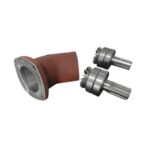Introduction
In the realm of metal casting, die casting and squeeze casting are two prominent techniques used to manufacture intricate metal components. While both processes involve injecting molten metal into a mold cavity, they differ in their approach, applications, and material properties.
This comprehensive guide explores the differences between die casting and squeeze casting, shedding light on their distinct characteristics and suitability for various industrial applications.
Die Casting
Die casting is a manufacturing process wherein molten metal is injected into a steel mold cavity under high pressure. The key features of die casting include:
- High Production Rates: Die casting allows for high-volume production of complex components with tight tolerances and excellent surface finish.
- Material Versatility: A wide range of metals and alloys, including aluminum, zinc, and magnesium, can be die cast to produce lightweight and durable parts.
- Minimal Post-Processing: Die casting typically requires minimal machining or finishing operations due to the precision and quality achieved in the casting process.



Squeeze Casting
Squeeze casting, also known as liquid metal forging, combines elements of casting and forging processes. It involves injecting molten metal into a semi-solid billet while applying pressure to consolidate the material. Key characteristics of squeeze casting include:
- Enhanced Mechanical Properties: Squeeze casting produces components with superior mechanical properties, such as higher tensile strength, elongation, and fatigue resistance.
- Near Net Shape: Squeeze casting can achieve near-net shape parts with minimal porosity and improved dimensional accuracy, reducing the need for secondary machining.
- Alloy Optimization: Squeeze casting allows for precise control over alloy composition and microstructure, enabling the production of customized components with tailored properties.
Differences and Applications
The primary differences between die casting and squeeze casting lie in their processing methods, material properties, and applications:
- Die Casting: Ideal for high-volume production of intricate components with tight tolerances, die casting is commonly used in automotive, aerospace, and consumer electronics industries.
- Squeeze Casting: Suited for producing components with superior mechanical properties and near-net shape geometries, squeeze casting finds applications in aerospace, defense, and automotive sectors where lightweight, high-strength parts are required.
Conclusion
In summary, die casting and squeeze casting are both valuable techniques in the realm of metal casting, each offering distinct advantages and applications.
While die casting excels in high-volume production of complex components with excellent surface finish, squeeze casting produces parts with enhanced mechanical properties and near-net shape geometries.
By understanding the differences between these processes, manufacturers can choose the most suitable casting method to meet their specific requirements and achieve optimal results in metal component production.
Drop me an email with your ideas, and I’ll get back to you swiftly!



















